Key Points:
- Common non-venomous snakes in Ohio include the eastern milk snake, eastern hognose snake, and gray rat snake.
- There are three venomous snakes in the state: the northern copperhead (only found in the hills of southeast Ohio), eastern massasauga (seen in 28 Ohio counties), and timber rattlesnake (very rare in Ohio).
- Three water snakes in Ohio that are considered “true” water snakes: the copper-bellied water snake, Lake Erie water snake, and northern water snake.
Ohio sits just at the start of the Midwest and Plains portion of the United States. It is often said to be the gateway to the great corn country of the Midwest. So it makes sense that geographically Ohio has several distinct regions that range from high hills to valleys and canyons with some pretty impressive natural caves.
It also has grasslands that run along the central region to sandy beaches and marshes along the shores of Lake Erie. These very unique regions provide fantastic habitats for many different types of snakes, including three types of venomous snakes.
Ohio’s snakes are mostly non-venomous, but any cornered snake will bite.
Let’s dive into some of the most important snakes to know in Ohio, along with pictures so you can better identify them.

Ohio has a variety of habitats that are attractive to different types of snakes.
©iStock.com/gustavofrazao
Common Non-Venomous Snakes in Ohio
The types of snakes that you will likely see when you’re in Ohio depend on where in the state you go. If you are near Lake Erie or some of the state’s bigger rivers you’ll probably see aquatic snakes. Up in the hills, you are more likely to venomous timber rattlesnakes.
Some of the most common non-venomous snakes that you’ll find in Ohio are:
Smooth Earth Snake (Virginia valeriae)

Smooth earth snakes are one of the smallest snakes you’ll find in Ohio.
©Matt Jeppson/Shutterstock.com
The smooth earth snake is typically only found in southern Ohio in areas like the Shawnee and Pike state forests. This particular snake is one of the smallest types of snakes found not just in Ohio, but the United States. It averages only 8 inches long and is never more than a foot long.
Smooth earth snakes have a gray or dark brown base color that helps them hide in the soil and at the base of trees in the forest. When you’re hiking in Shawnee or Pike forests make sure that you’re checking the bases of trees, old logs, and underneath leaf piles for snakes. That’s where smooth earth snakes prefer to hide.
Eastern Milk Snake (Lampropeltis triangulum)
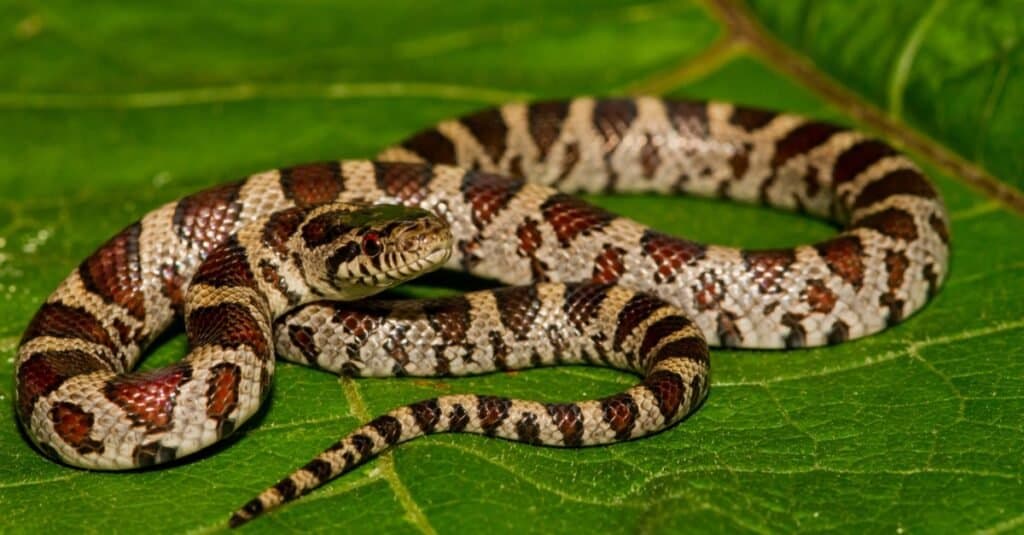
Eastern milk snakes are beneficial animals, especially for farmers, as they hunt small rodents often found on farms.
©Jay Ondreicka/Shutterstock.com
The eastern milk snake is also sometimes called the “farmer’s friend”. That’s because this snake thrives on rodents of all kinds. Usually, the eastern milk snake is found in the woods, in meadows, on farms, and in barns and outbuildings where it can find a lot of rodents to eat. Eastern milk snakes are typically reddish-brown or brown with black markings.
They don’t often get to be longer than about 3 feet long although they can be as small as 2 feet long.
Gray Rat Snake (Pantherophis spiloides)

There are reports of gray rat snakes reaching 8 feet in length.
©Gabbie Berry/Shutterstock.com
Non-venomous gray rat snakes can reach significant lengths, sometimes up to six feet in length, with some reports of individuals that even reach 8 feet in length! They range from Ohio, up into New York, to the Mississippi River. While a number of snakes can reach similar sizes, they’re generally considered the largest species of snake in Ohio.
The gray rat snake can easily climb trees so you might see one on the ground hidden among the brush or grass or you could look up and see one hanging in a tree above you. That’s enough to give enough a startle! They’ll often even climb to eat eggs from bird’s nests high up in trees.
The snake has a solid dull black color that makes it look frightening. However, the gray rat snake is very helpful to humans. It eats a wide variety of rodents and pests. So if you see one of these snakes in an outbuilding, or a garage, or when you’re walking in the woods, don’t be alarmed.
Eastern Hognose Snake (Heterodon platirhinos)
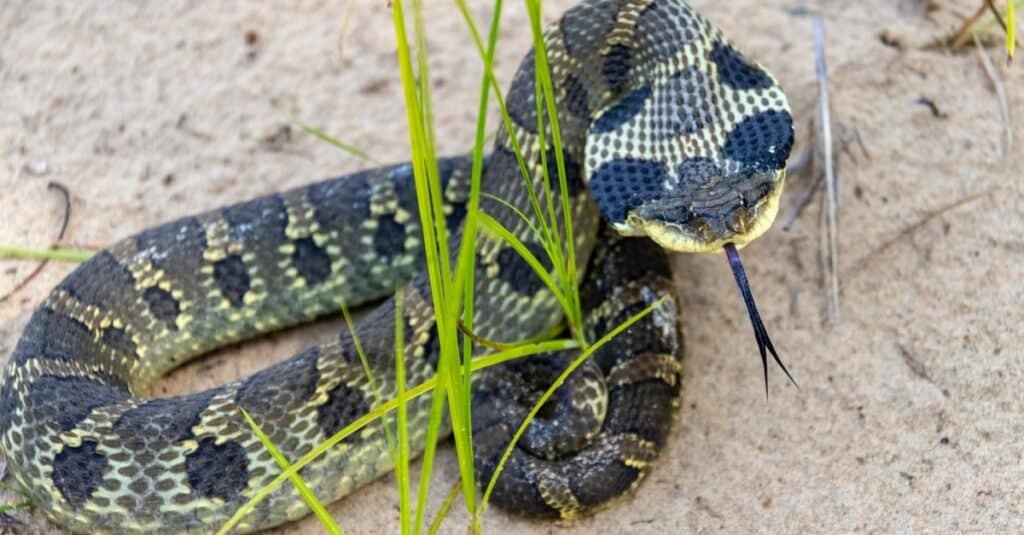
The eastern hognose snake will flatten its head and neck and hiss loudly when threatened.
©IHX/Shutterstock.com
You can’t miss an eastern hognose snake. Thanks to the unique shape of the nose this snake has you will always be able to identify it. Primarily the hognose snake is found in northwest Ohio and the hills of southern Ohio. In the United States, there are four species of hognose snake.
- The eastern hognose (H. platirhinos) is found in Ohio and most of the eastern United States.
- Western hognose (H. nasicus) is found more in the prairies to the Rocky Mountains.
- Southern hognose (H. simus) occurs in a few southeastern states.
- Mexican hognose (H. kennerlyi) inhabits areas of southern Texas and northern Mexico.
If you see a snake with an upturned nose that kind of falls off to one side like a tent flap that’s a hognose snake. They love sandy loose soil where they can dig themselves down and be hidden from view. Hognose snakes have a lot of variety in their coloring depending on what their habitat is like. Their coloring is designed to help them blend in.
Eastern Fox Snake (Pantherophis vulpinus)

Eastern fox snakes live close to Toledo and islands in Lake Erie in marshland habitats.
©Ryan M. Bolton/Shutterstock.com
The eastern fox snake might give you a scare if you just look quickly. It has an orange-brown color similar to the color of a copperhead snake, which is venomous. But the eastern fox snake is not venomous. You will find eastern fox snakes along the southwestern shore of Lake Erie and to the west of Sandusky in Ohio. While their range is limited to a small portion of the state, they can grow quite large, sometimes reaching 5 feet in length. While they’re often mistaken for venomous snakes because of their coloration, they’re not dangerous but will vibrate their tail to imitate rattlesnakes if they feel threatened.
Water Snakes in Ohio
There are three water snakes in Ohio that are considered “true” water snakes:
- Copper-bellied water snake
- Lake Erie water snake
- Northern water snake.
Each of these Ohio snakes is highly aquatic. Does this mean that they’re the only three snakes you could find in the water across the state? Far from it! Snakes you saw earlier on the list such as the eastern fox snake and gray rat snake are quite adept in water environments. The fact is, many snakes can be strong swimmers, but some snakes do specialize in hunting in the water. Let’s take a look at one of these water snakes.
Copper-Bellied Water Snake (Nerodia erythrograster neglecta)
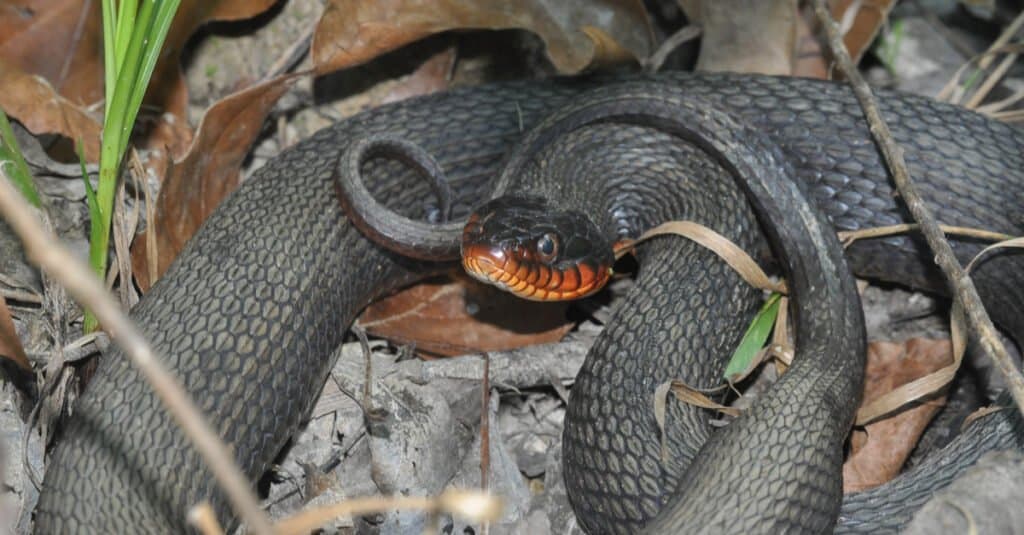
The copper-bellied water snake is only found in Williams County.
©Mike Wilhelm/Shutterstock.com
In Ohio, the copper-bellied water snake is very rare. The only known colony of copper-bellied water snakes is in Williams County, which is on the border with Indiana and Michigan. Part of the reason for that is that these snakes are mostly aquatic and live only in shallow wetlands where they can find frogs and other food sources.
This snakes species averages 3-4 feet long. The snake’s base color is almost always black but it can be dark gray also. The snake has a bright orange-red or red belly which is where the name comes from.
Northern Water Snake (Nerodia sipedon)

Northern water snakes are found across much of Ohio.
©jmarino/Shutterstock.com
While the copper-bellied snake is limited to just a small population in Ohio, northern water snakes are abundant across the state. They can often be found basking on rocks next to bodies of water. The snakes have a pattern that’s most often confused with water mocassins (cottonmouths), yet they’re not poisonous. While water snakes in Ohio aren’t venomous, they still should not be handled. These snakes are quick to defend themselves and can leave painful bites that while not deadly, can be quite painful.
3 Venomous Snakes in Ohio
There are just three types of venomous snakes in Ohio, and one of them is so rare you will likely never encounter it. The venomous snakes in Ohio are:
Northern Copperhead Snake (Agkistrodon contortrix mokasen)

The northern copperhead makes its home in Ohio in the state’s southeast hills.
©iStock.com/David Kenny
Copperheads are smaller venomous snakes and are just 2-3 feet long. The northern copperhead has a heavy and wide body that is copper, orange, or pinkish-orange in color with brown or tan markings. The marking are not uniform. Copperhead snakes are only found in the hills of southeast Ohio.
If you do come across a copperhead snake give it a lot of space. A northern copperhead won’t attack unless it feels cornered or threatened.
Eastern Massasauga Snake (Sistrurus catenatus)
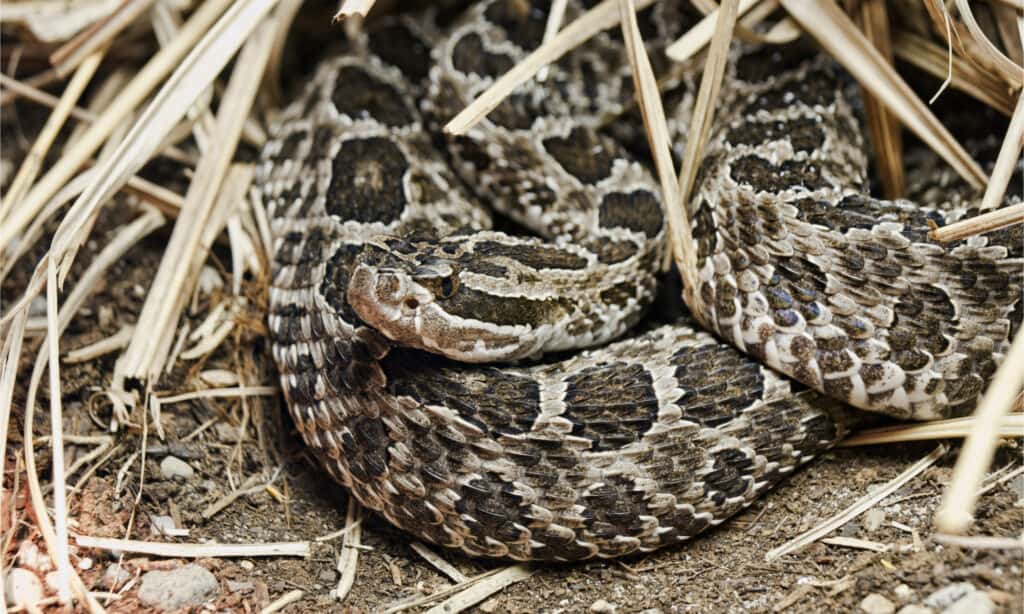
Eastern massasaugas are found most often in swamps and wet prairies.
©DnDavis/Shutterstock.com
The eastern massasauga is the most widespread venomous snake in Ohio when it comes to historical range. It’s a very small snake that averages about 3 feet long. But it does have potent venom. You may run across the eastern massasauga in 28 different Ohio counties, but it’s becoming increasingly rare. The areas with the highest concentrations of eastern massasauga snakes are Cedar Bog, Killdeer Plains, and Mosquito Creek.
Timber Rattlesnake (Crotalus horridus)

Be careful around timber rattlesnakes, as most bites occur due to their excellent camouflage.
©Frode Jacobsen/Shutterstock.com
Timber rattlesnakes in Ohio are very rare and are only sometimes seen in the southeastern part of the state. Even though the timber rattlesnake is the most venomous of all the snakes in Ohio, it doesn’t often attack people. Producing venom isn’t easy for snakes and they don’t waste it. Even if a venomous snake does bite you it may not use venom because of the effort involved in creating more venom.
Summary of Common Snakes in Ohio
Here’s a recap of the snakes commonly found in the state of Ohio that we took a close look at:
| Number | Snake | Type |
|---|---|---|
| 1 | Smooth Earth Snake | Non-Venomous |
| 2 | Eastern Milk Snake | Non-Venomous |
| 3 | Gray Rat Snake | Non-Venomous |
| 4 | Eastern Hognose Snake | Non-Venomous |
| 5 | Eastern Fox Snake | Non-Venomous |
| 6 | Copper-Bellied Water Snake | Non-Venomous |
| 7 | Northern Water Snake | Non-Venomous |
| 8 | Northern Copperhead Snake | Venomous |
| 9 | Eastern Massasauga Snake | Venomous |
| 10 | Timber Rattlesnake | Venomous |
The Complete List: 28 Types of Snakes in Ohio
It might seem like there are a lot of different kinds of snakes in Ohio but some of them are just different subspecies of the same species of snake. For example, there are several different types of garter snakes that live in Ohio. In addition, some snakes live close to the borders and have limited distribution across the state.
With that being said, here is a complete list of the 28 snakes that can be found in Ohio:
- Copper-Bellied Water Snake
- Plains Garter Snake
- Smooth Green Snake
- Northern Ring-Necked Snake
- Hognose Snake
- Eastern Milk Snake
- Gray Rat Snake
- Copperheads
- Eastern Massasauga Rattlesnake
- Timber Rattlesnake
- Queen Snake
- Kirtland’s Snake
- Brown Snake
- Northern Red Bellied Snake
- Smooth Earth Snake
- Worm Snake
- Northern Black Racer – Eastern Ohio
- Blue Racer – Western Ohio
- Eastern Fox Snake
- Fox Snake
- Eastern Black Kingsnake
- Eastern Garter Snake
- Plains Garter Snake
- Butler’s Garter Snake
- Ribbon Snake
- Rough Green Snake
- Smooth Green Snake
- Lake Erie Water Snake.
Other Reptiles Found in Ohio
Bullfrogs

The bullfrog is the biggest frog found in North America.
©iStock.com/edb3_16
The largest frog in North America, with lengths of up to 8 inches and weights reaching 1.5 pounds, is the very common bullfrog. This frog is native to the central and eastern United States, although it is currently found throughout the United States, including Hawaii, as it was introduced to these areas by people that wanted to use it for sport fishing and food.
Bullfrogs are very prolific breeders, laying up to 20,000 eggs at one time, compared to native frogs that can only lay 2,000 to 3,000 eggs, which gives them an advantage in numbers. Males elicit the croaking sound during mating season, which some say resembles the mooing of a cow, which is how this amphibian earned its name, “bull” frog. With the exception of the breeding season, these reptiles are generally solitary.
Eastern Box Turtles
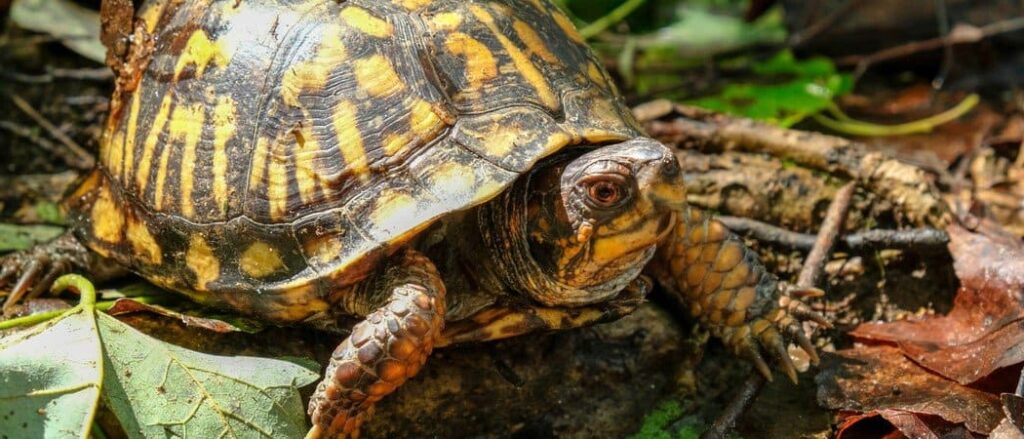
The eastern
box turtle
‘s lifespan can range between 25 and 100 years.
©samray/Shutterstock.com
Eastern Box turtles are terrestrial turtles, unable to tolerate high temperatures, and are most active in the morning, especially in summer months. These reptiles can live 25 to 100 years of age and are also able to retain water better than aquatic turtles, which helps them during dry periods. Average shell lengths can be from 5 to 6 inches and weights are 1 to 2 pounds. While this is not normally an aggressive turtle, they do bite when they feel threatened and males have been known to show aggression although it is only toward each other. With a hinged shell, this reptile is able to retract all of its limbs and head inside of its “box” to protect itself and will remain inside until it feels the threat has passed. The shell is extremely tough and is virtually impossible to pry open.
The photo featured at the top of this post is © iStock.com/David Kenny
Discover the "Monster" Snake 5X Bigger than an Anaconda
Every day A-Z Animals sends out some of the most incredible facts in the world from our free newsletter. Want to discover the 10 most beautiful snakes in the world, a "snake island" where you're never more than 3 feet from danger, or a "monster" snake 5X larger than an anaconda? Then sign up right now and you'll start receiving our daily newsletter absolutely free.
FAQs (Frequently Asked Questions)
How many poisonous snakes are in Ohio
There are three snakes in Ohio that are poisonous (venomous). They include the timber rattlesnake, the massasauga, and the copperhead. The last known fatality from a snake bite in Ohio was in 1947. A woman was bitten by a timber rattlesnake and died the next day.
What black snakes are in Ohio?
The most common “black snake” in Ohio is likely the gray rat snake, which is sometimes known as the black snake. Other snakes in the state that can be black include the copper-bellied water snake, northern ring-necked snake, racer, eastern black kingsnake, and some garter snakes.
How many rattlesnakes are in Ohio?
There are two types of rattlesnakes in Ohio: the massasauga and the timber rattlesnake.
Thank you for reading! Have some feedback for us? Contact the AZ Animals editorial team.






